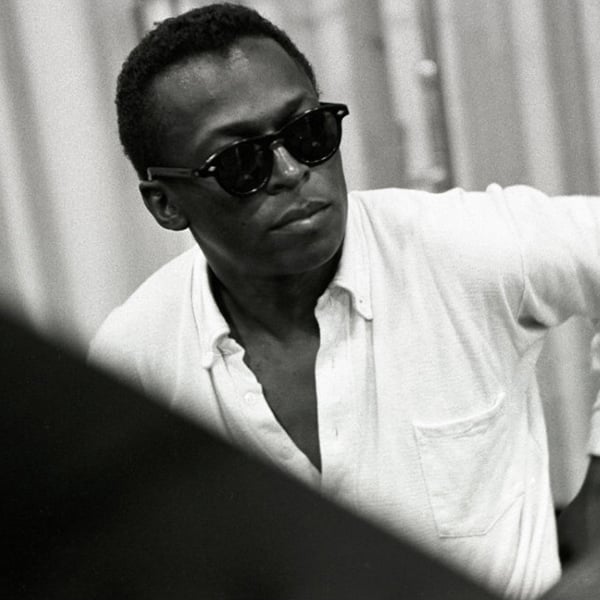
Kind of Blue is arguably Miles’ greatest hit, the one album with which he is most associated. It is still one of the most popular jazz albums of all time, outselling most contemporary recordings and prized as a harbinger of modal jazz and revered as a paradigm of improvisation over reduced harmony—creating a perfect balance of sound and space. Outside the jazz realm, it is consistently chosen by music historians and critics as one of the best albums of all time, alongside evergreen classics by The Beatles, Elvis Presley, and others.
Inspired by many ideas—mood-painting, modal structures—behind the soundtrack to Elevator to the Gallows, Kind of Blue can be seen as Miles’ signature work not only in its enduring popularity, but its attitude as well; in many ways the album’s cool and aloof effect, with its minimal, almost dismissive musical gestures, serves as a sonic reflection of Miles legendary aloofness. The title of its famous opening track—“So What”—is a perfect reflection of Miles’ insouciant, sunglasses-at-midnight way of being.
Numerous other elements specific to Kind of Blue push it to the top of the “Best Of” lists: the all-star sextet Miles had assembled to accompany him, including three players (John Coltrane, Bill Evans, Cannonball Adderley) who would themselves prove to be jazz legends, and a rhythm section (Wynton Kelly, Paul Chambers, Jimmy Cobb) that outswung any other in its day. There was the shared feeling of fresh discovery in the studio on those two days in 1959, as almost all the tracks were the first complete takes—no edits, no second tries. There was Bill Evans’ evocative essay on the album’s back cover highlighting that idea of “first-mind, best-mind”, comparing their music to the spontaneous, unerasable ink-on-rice-paper work of a Japanese calligrapher.
As the title suggests, Kind of Blue was an exercise not only in primarily blues structures, but also in generating an abiding melancholy through the album’s five tracks—an emotional cohesion unlike any other title in Davis’ catalog. As basic as the structures are—a deliberate choice on Miles’ part to move away from the harmonic complexity of bebop—they proved that an emotional depth could be achieved by great improvisers utilizing simple scales or modes (hence “modal” jazz) rather than chord sequences. All five of the tracks—“So What,” “Freddie Freeloader,” “Blue in Green,” “Flamenco Sketches,” and “All Blues”—today serve as a Bible on improvisation to musicians of all instruments and all levels: the solos as closely studied as the tunes themselves.
Take Miles’ “So What” solo: it’s a brief, two unhurried choruses that go by in no time at all, featuring the laconic, behind-the-beat phrasing of his skinny-tie period, unfolding in call-and-response patterns faintly echoing the opening theme. Paolo Fresu, one of Europe’s premier trumpet and flugelhorn players who teaches at Università di Bologna, uses it as a primer for first-year music students, showing “how creative they can be, how much emotion they can get to, even at the beginning. “It is so easy and so clear. Most solos jump up and down octaves. Miles keeps it simple, like it’s a new melody.”
The lasting value of a recorded masterpiece lies not only in the notion of reaching and grasping the music itself, but in using it as a doorway to other pathways. Kind of Blue, it can be argued, earns its accolades less for its continuing sales or critical popularity, and more for its long-serving role as the portal for so many who come to jazz for the first time.
How did Miles himself feel about Kind of Blue? Ironically, he described it as a “failed experiment” in his autobiography, explaining that the album did not fully realize the sounds he had been hearing in his head before the session. Nonetheless, in an 1986 interview, when pianist/journalist Ben Sidran remarked that Kind of Blue is probably the number one jazz record on virtually all the jazz critics’ lists, his sincere answer was short but held a palpable sense of pride: “Isn’t that something.”
Kind of Blue came and went in Miles’ view, soon followed by another big band project directed by arranger Gil Evans, one which demanded many hours of takes and re-takes—the opposite of the first-take ideal of Kind of Blue. Sketches of Spain would prove to be another hit, a followup that helped cement Miles’ musical stature through the 1960s and up until today.















































